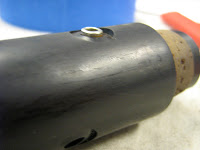Welcome back. It's been a few weeks since the last post. We've finished the program and graduated away. Here are a few little finishing notes.
In the beginning of the week we modified our swedging tool to make it easier to work. By turning down the length of the tool, we could add a bearing that reduced friction.
Back to the crack pinning, we continued to sand and polish the bodies to blend in the patches. Using oils and sharpies, we blend the colors as best as possible.
Finally, to finish up the roller I chucked the outside of the roller on the mini-lathe and polished all of the machine marks out of it. After quite a while of polishing, I used loc-tite to glue the bearings to the inner-rod and the tube. After setting overnight, she is good to use.
It has been quite the year. I will try to post occasionally whenever something fantastic comes through the shop, or when I make any new tools. Thanks to Red Wing for everything. If you have any questions or comments, email me at airbandrepair@gmail.com.
In the beginning of the week we modified our swedging tool to make it easier to work. By turning down the length of the tool, we could add a bearing that reduced friction.
Back to the crack pinning, we continued to sand and polish the bodies to blend in the patches. Using oils and sharpies, we blend the colors as best as possible.
Finally, to finish up the roller I chucked the outside of the roller on the mini-lathe and polished all of the machine marks out of it. After quite a while of polishing, I used loc-tite to glue the bearings to the inner-rod and the tube. After setting overnight, she is good to use.
It has been quite the year. I will try to post occasionally whenever something fantastic comes through the shop, or when I make any new tools. Thanks to Red Wing for everything. If you have any questions or comments, email me at airbandrepair@gmail.com.




















































